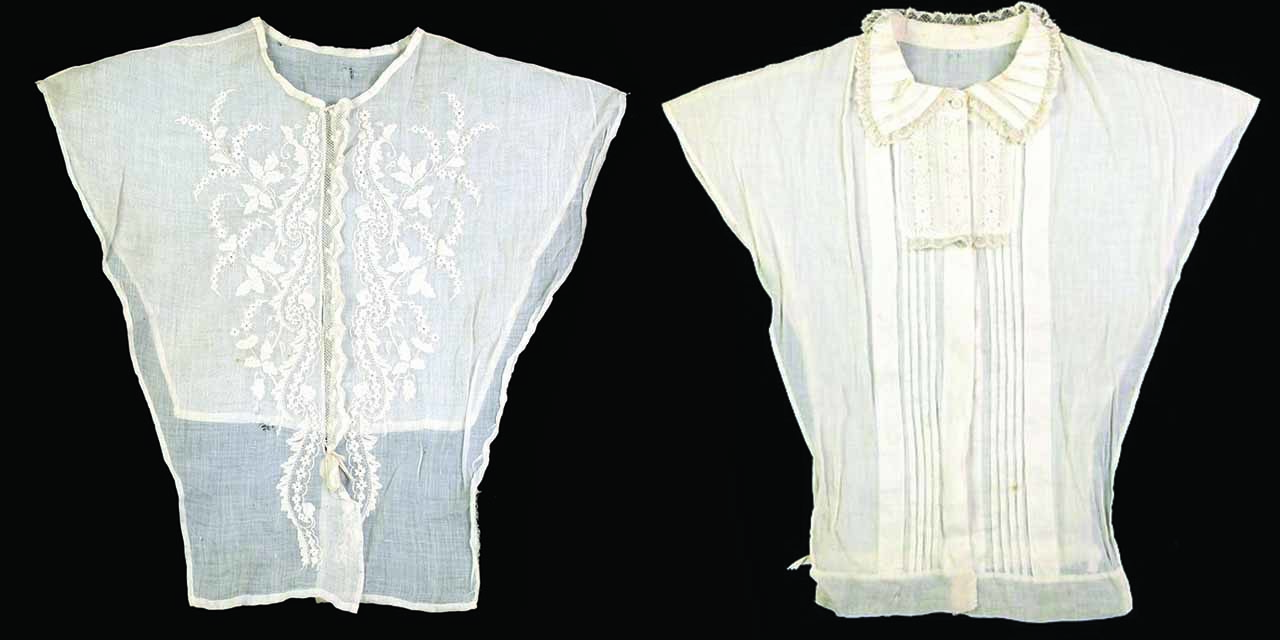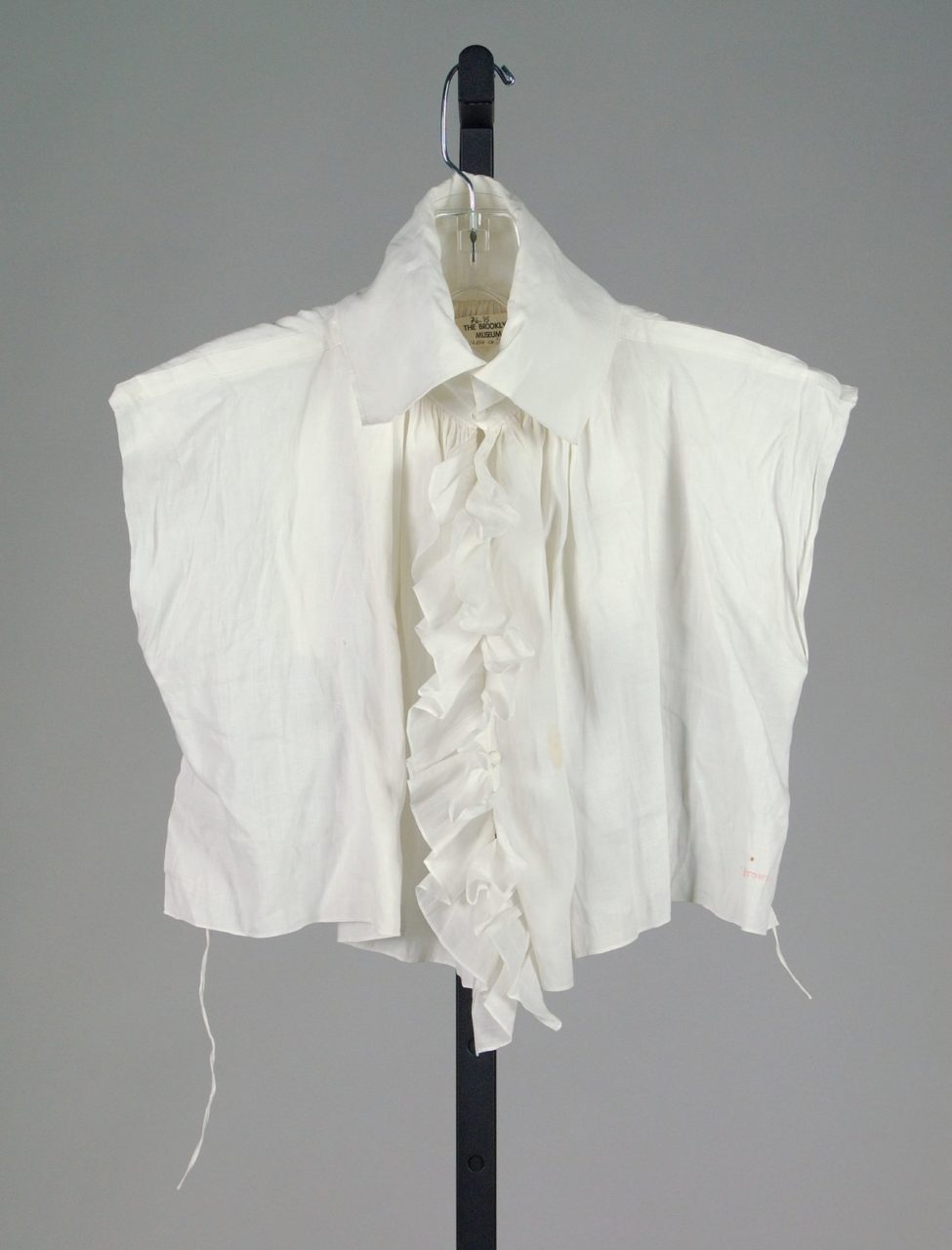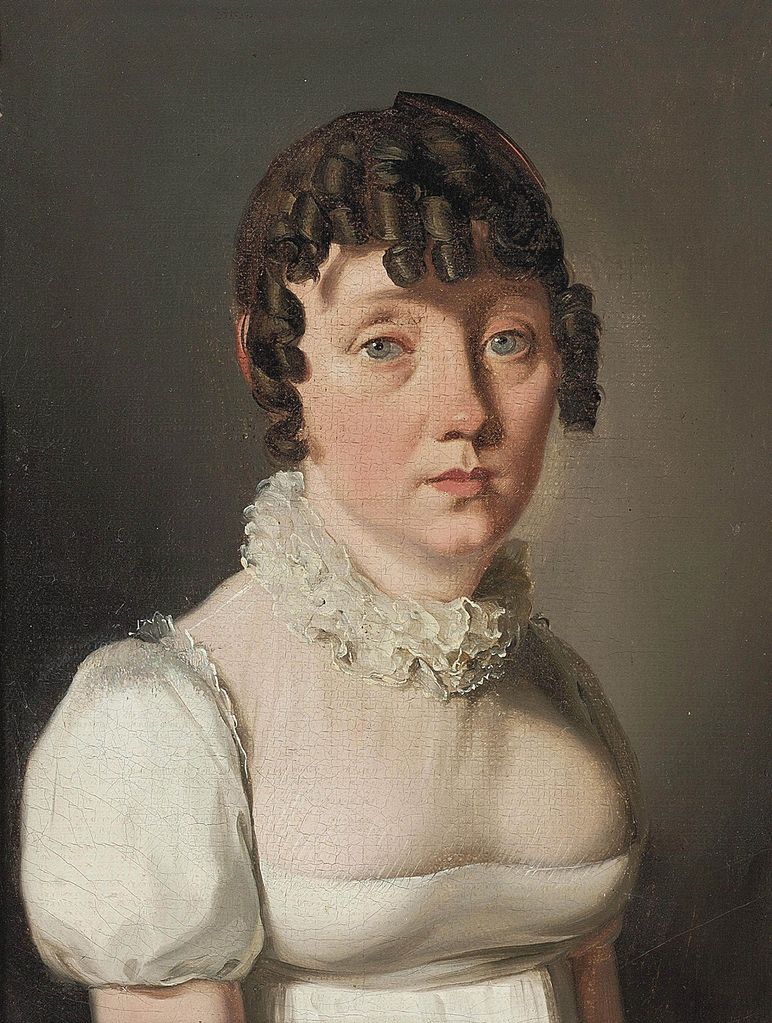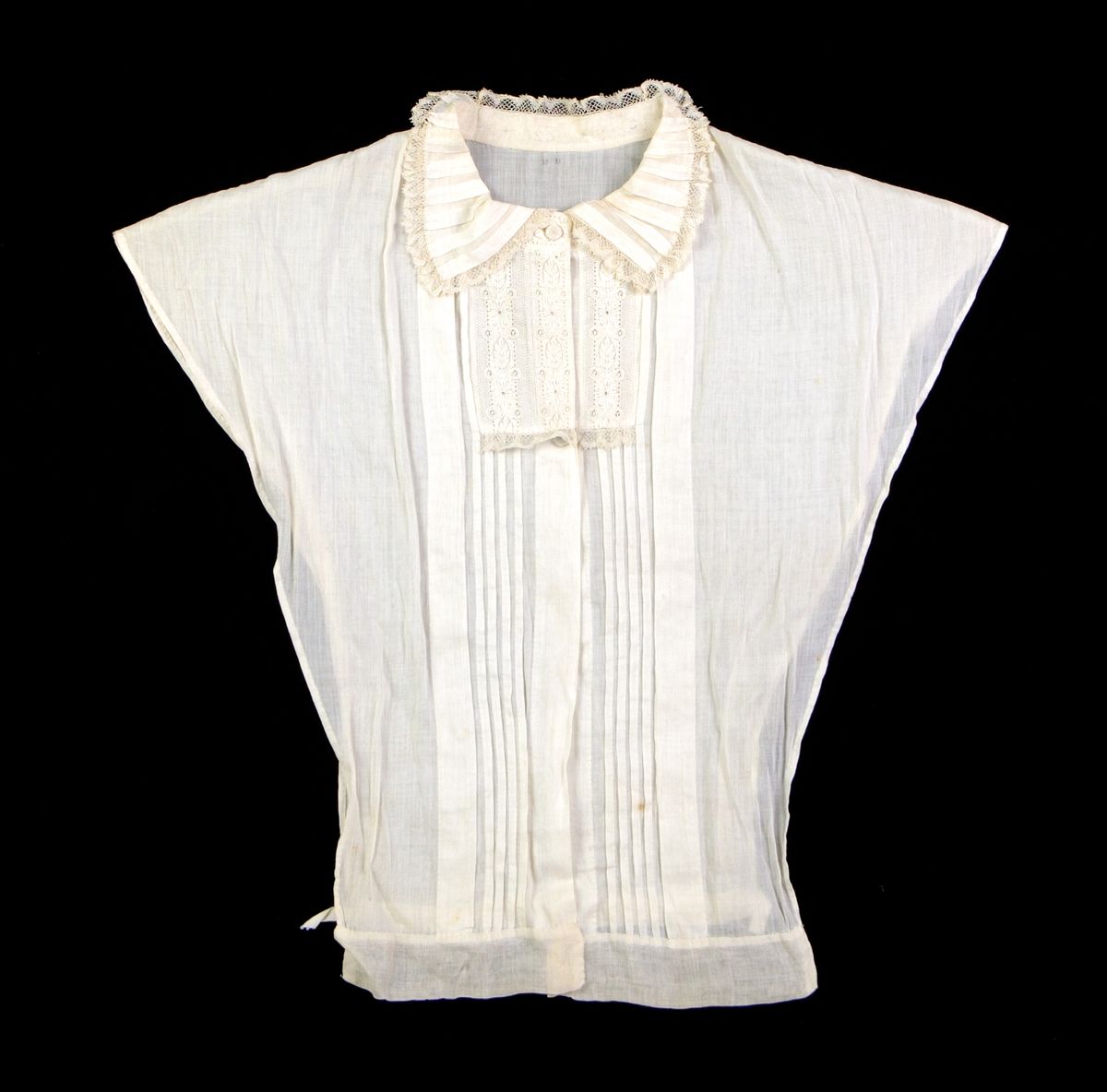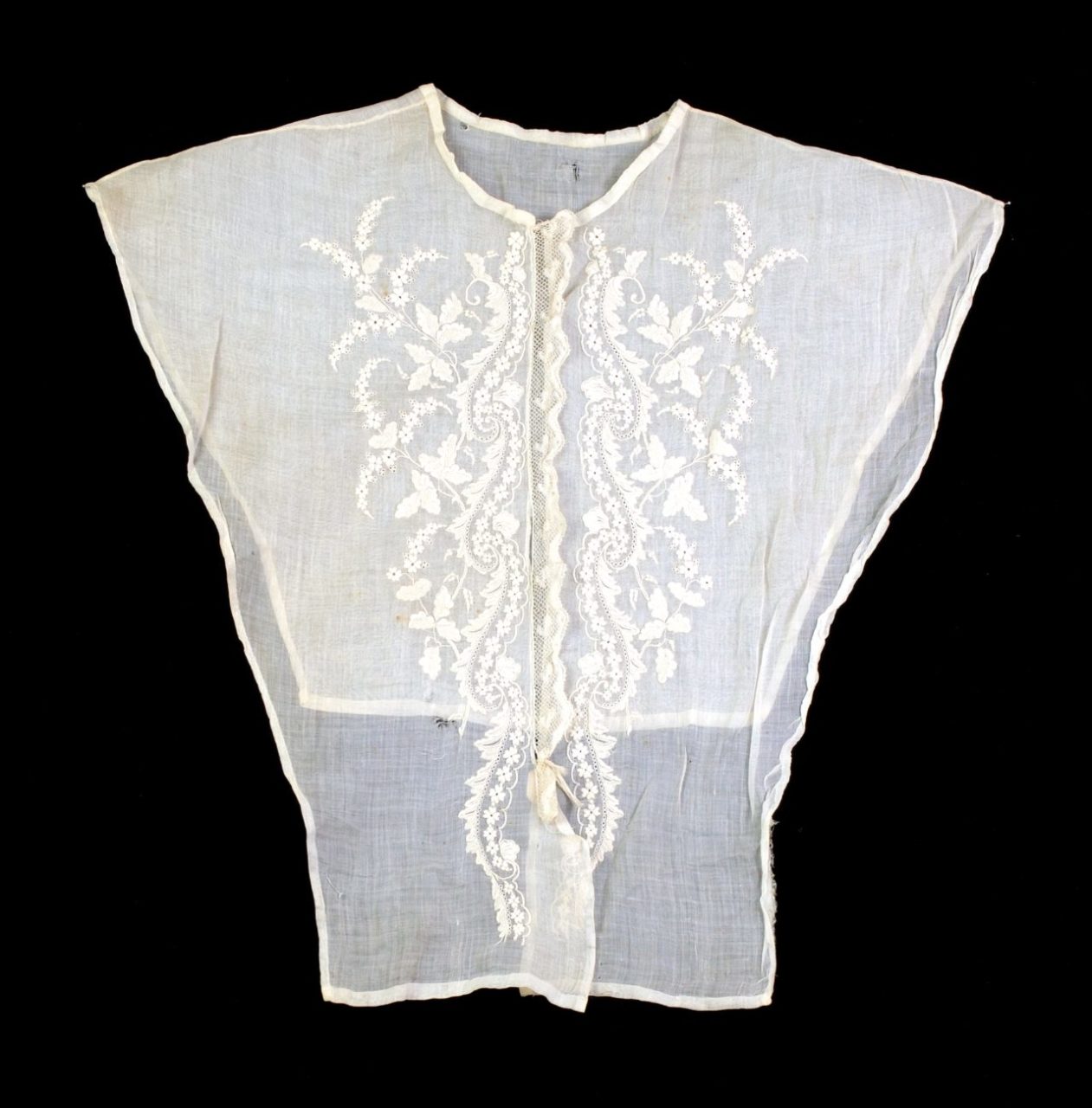A piece of fabric worn under bodices in the 19th century to fill in low necklines for modesty and decoration.
The Details
Mary Brooks Picken, the author of The Fashion Dictionary (1973), writes that a chemisette is a:
“Plain or ornamental sleeveless underbodice covering neck, shoulders and breast; usually made of muslin or lace. Worn by women in late 19th century, generally to fill in neckline of dress. French term for vestee, gilet, etc.” (59)
Figure 1 shows a typical, fairly simple chemisette from the 1860s; the small collar with delicate bits of lace would be all that was seen. The chemisette shown in figure 2 was worn decades earlier, possibly even in the late 18th century, and likely under a redingote. Thomas Delantanville’s A New French Dictionary (1771) informs the reader:
“Chemisette: a sort of waistcoat.” (80)
Replacing a full chemise with a sleeveless, waist-less chemisette enabled a tighter fit on the bodice covering it.
Blanco, Doering, Hunt-Hurst, and Lee, the authors of Clothing and Fashion: American Fashion From Head To Toe (2015), write of the chemisette:
“Another item of underwear worn by women was the chemisette. This was a half-bodice of linen or cotton trimmed with lace and other decorative features. The chemisette was worn to fill in low necklines of dresses for day wear. The neckline and collar of the chemisette were [adjusted to be] fashionable…since it was worn throughout the period.” (255)
Notice the frilled, high neckline of the chemisette in figure 3; this would have been suitable for women’s fashions in the early part of the century (Fig. 4), whereas the subdued collar in figure 5 dates to the last part of the Victorian era.
Alison Carter, author of Underwear, The Fashion History (1992), writes that a chemisette is:
“A vestigial garment designed to show at the neck. A false chemise-front, or modest-piece popular throughout the C19th diminishing almost to a collar during the 1880s.” (151)
Some chemisettes were meant to tie around one’s waist (Figs. 2 & 3) while others were tucked into the skirt (Fig. 5) or pinned to the clothing underneath (Fig. 6). While some were simply plain, serviceable linen or cotton, others had very fine whitework embroidery and lace like the 1835-40 example in figure 6.
An issue of Arthur’s Home Magazine from 1870 quotes a slightly earlier article from Madame Demorest’s:
“Chemisettes and fichus, trimmed with strips of insertion, and borders in point lace, are very fashionable. White bodices are nearly gone out of fashion. All the skill of our lingeres is now expended upon chemisettes of various kind, to wear with low, open dress-bodices. The shape of the chemisette, of course, varies according to that of the dress-bodice, which is either square, round, or heart-shaped.” (128)
The Dictionary of Fashion History by Valerie Cumming and C. W. & P.E. Cunnington (2010) defines chemisette by period, demonstrating that the term continued into the twentieth century:
“19th century: In the first half of the century, a high-necked and sleeveless, white muslin or cambric fill-in to the bodice of a day gown, cut low in front. By the 1860s, a long-sleeved blouse.
20th century: Lace or fabric insert into the décolletage of a low-cut dress.”
This Dictionary claims a chemisette turned from a bib into a full sleeved garment (Fig. 5). This is not precisely true, as the bib version continued to be used throughout the century. It appears that the sleeved versions, while in some cases possibly described only as “chemisettes”, were more commonly described as “full-bodied” or “full” chemisettes, “long-sleeved chemisettes,” “full-sleeved chemisette,” and sometimes a “body en chemisette” (‘body’ and ‘waist’ being period words for ‘bodice’ or ‘blouse’). A short-sleeved chemisette dating to around 1900 can be seen in figure 7.
Fig. 1 - Maker unknown (American). Chemisette, ca. 1860. Linen. New York: The Metropolitan Museum of Art, 2009.300.4050. Brooklyn Museum Costume Collection at The Metropolitan Museum of Art, Gift of the Brooklyn Museum, 2009; Bequest of Samuel E. Haslett, 1921. Source: MMA
Fig. 2 - Maker unknown (British). Chemisette, 1790–1805. Linen. New York: The Metropolitan Museum of Art, 2009.300.5869. Brooklyn Museum Costume Collection at The Metropolitan Museum of Art, Gift of the Brooklyn Museum, 2009; Augustus Graham School of Design Fund, 1976. Source: MMA
Fig. 3 - Maker unknown (French). Chemisette, 1810-30. Cotton. New York: The Metropolitan Museum of Art, 08.86.12. Gift of W. J. Baer, 1908. Source: MMA
Fig. 4 - Louis-Léopold Boilly (French, 1761-1845). Portrait of a lady in a white dress with lace collar, ca. 1815. Oil on canvas. Private collection. Source: The Athenaeum
Fig. 5 - Maker unknown (American). Chemisette, 1875-99. Cotton. New York: The Metropolitan Museum of Art, 2009.300.4353. Brooklyn Museum Costume Collection at The Metropolitan Museum of Art, Gift of the Brooklyn Museum, 2009; Gift of Louise M. Coleman, 1941. Source: MMA
Fig. 6 - Maker unknown (American). Chemisette, 1835-40. Cotton. New York: The Metropolitan Museum of Art, 2009.300.4092. Brooklyn Museum Costume Collection at The Metropolitan Museum of Art, Gift of the Brooklyn Museum, 2009; Gift of Mrs. Willis McDonald, 1925. Source: MMA
Fig. 7 - Maker unknown (American or European). Chemisette, ca. 1900. New York: The Metropolitan Museum of Art, C.I.43.65.2. Gift of Richard Kent, 1943. Source: MMA
References:
- Blanco, José F., Mary D. Doering, Patricia Hunt-Hurst, and Heather Vaughan Lee. Clothing and Fashion: American Fashion from Head to Toe. Santa Barbara, CA: ABC-CLIO, 2016. http://www.worldcat.org/oclc/1053555823
- Carter, Alison J. Underwear, the Fashion History. New York: Drama Book Publishers, 1992. http://www.worldcat.org/oclc/437680383
- Cumming, Valerie, C. W. Cunnington, and P. E. Cunnington. “Chemisette.” In The Dictionary of Fashion History, 46. Oxford: Berg Publishers, 2010. Accessed November 25, 2019. https://www.bloomsburyfashioncentral.com/products/berg-fashion-library/dictionary/the-dictionary-of-fashion-history/chemisette.
- Delantanville, Thomas. A New French Dictionary. London: J. Nourse and P. Vaillant, 1771. Google Books. Accessed 25 November 2019. Link.
- “Fashions for September.” Arthur’s Home Magazine 36 (August 1870): 128. Google Books. Accessed 25 November 2019. Link.
- Picken, Mary Brooks. A Dictionary of Costume and Fashion: Historic and Modern. Mineola, NY: Dover Publications, 1999. Google Books. Accessed October 01, 2018. http://www.worldcat.org/oclc/1002899833

